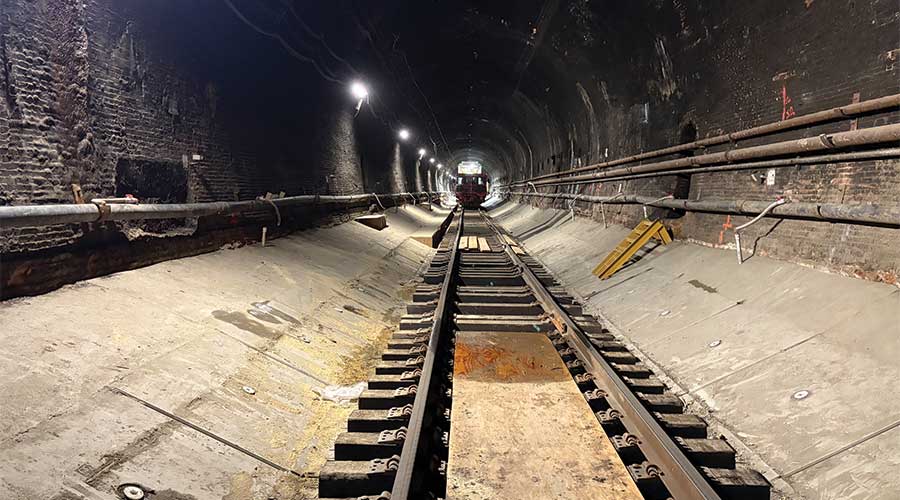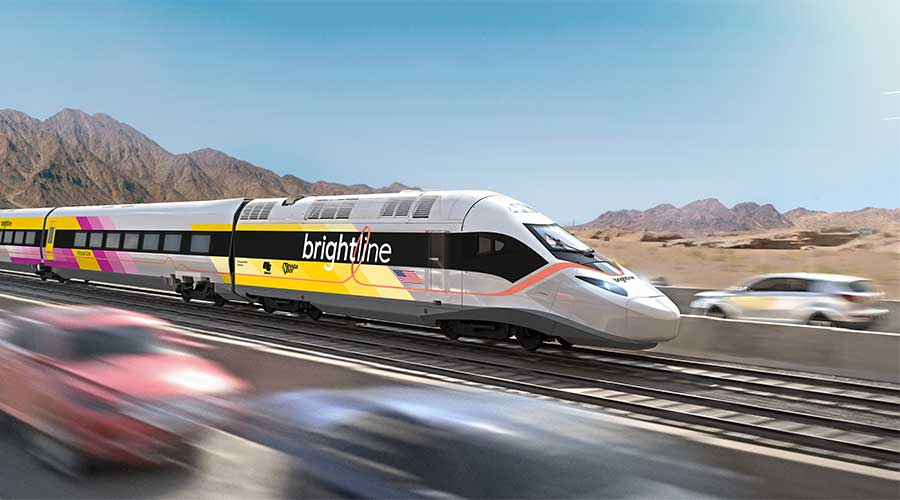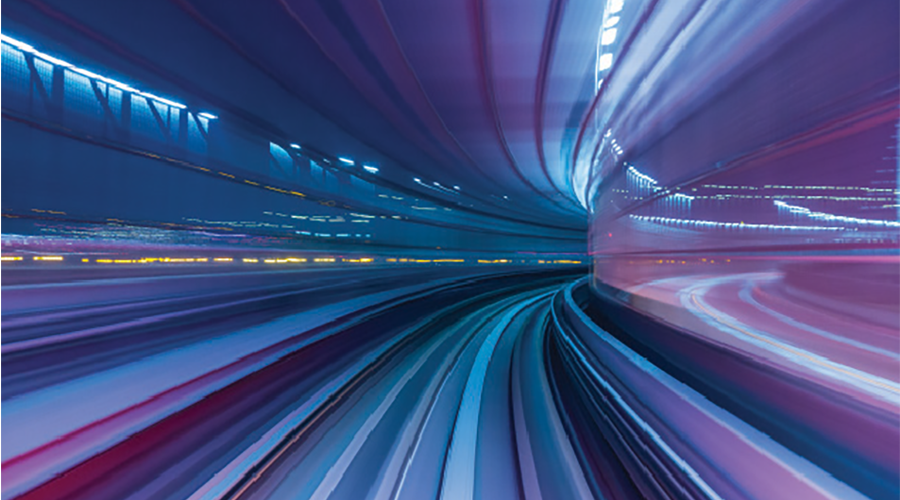Stay updated on news, articles and information for the rail industry
May 2015
Rail News: Passenger Rail
How transit agencies are trying to attract millennial riders
— by Julie Sneider, senior associate editor
Millennials — defined as people between the ages of 18 and 34 — are members of the largest and most diverse generation in American history. Their adroitness at using technology and their predisposition for living in urban neighborhoods and taking a train or bus to get around is already influencing trends in the transportation field. That's what the American Public Transportation Association (APTA) concluded in its 2014 report, "Millennials & Mobility: Understanding the Millennial Mindset." The study examined what is driving the millennial generation’s transportation choices, what will drive those choices in the future, and the opportunities for the transit industry to capitalize on those choices.
The reasons behind millennials' transportation decisions are pragmatic: They ride trains and buses primarily for convenience and to save money. At the same time, they have high expectations for the transit services they use: 61 percent want to see more reliable systems; 55 percent expect real-time updates and wireless Internet service wherever they go; and 44 percent want a more user-friendly travel experience over the next decade.
Other studies have reached similar conclusions. In October 2014, the U.S. Public Interest Research Group (U.S. PIRG) Education Fund concluded in its "Millennials in Motion" report that millennials’ shift away from driving cars over the past 10 years is likely to continue. Census data indicate that the share of 16- to 24-year-olds who drive to work declined by 1.5 percentage points between 2006 and 2013, while the percentage of young people getting to work by public transportation, foot or bicycle increased.
A love affair with cars? Not so much
Also last year, Transportation for America — a division of the nonprofit Smart Growth America coalition — and The Rockefeller Foundation sponsored a survey that found a majority of millennials want access to public transportation options so they don’t have to rely so much on owning and driving a car. More than half — 54 percent — of those surveyed said they would consider moving to another city if it offered better options for transit; 66 percent said having access to high-quality transportation is one of their top three criteria when deciding where to live.
The results spoke to the incentive for cities to invest in transit networks as a way to attract and retain a younger workforce, says David Goldberg, communications director for Transportation for America and vice president of strategy for Smart Growth America.
Employers are starting to act on millennials' preferences, Goldberg says, noting recent announcements by major corporations such as Marriott International and State Farm Insurance that are moving major operations to vibrant urban locations that offer easy access to transit systems.
"Employers are looking to set up in places where the talented millennials want to be," he says. "The millennials are a great target market for transit agencies. They actually see transit as part of a bundle of services that are tied up with hip, urban living."
Given the under-35 generation's tendency to feel positive about using transit, it might be natural for some urban planners to presume that if you build a light-rail or bus line, the millennial riders will come. However, transit agency executives shouldn’t take those attitudes for granted, says Goldberg.
"Transit agencies right now have a really good opportunity that I'm not sure they're capitalizing on to the degree that they could," he says. "To attract and keep these riders, it’s really about patron services. It's thinking in a more agile way about the change that’s underfoot and the incredible energy that could support the growth for transit." Agencies need to be nimble at adapting to new technology. They should structure their systems to take full advantage of smartphone technology that provides real-time information and other data about what’s going on with their system, Goldberg says. They also should employ technology that helps riders connect with last-mile services such as bike share, Uber or Zipcar, he believes.
Marketing to a younger audience
Transit-industry executives whose agencies are aiming to attract millennial-age riders observe that the generation presents different challenges than previous generations when it comes to marketing and communications.
"They're the most tech-savvy generation, and they're the most cynical when it comes to traditional advertising versus word of mouth, recommendations from friends and social networks," says Nevin Grinnell, chief marketing officer and vice president of marketing communications for Dallas Area Rapid Transit (DART).
Moreover, millennials grew up in tough economic times and are getting their driver's license later in life. Those two things bode well for public transportation, Grinnell says. Consequently, DART is using technology in new ways to reach millennial-age customers. One example is the "GoPass," which DART launched in September 2013. The mobile ticketing application allows purchasers to use smartphones to buy a regional pass that's good for rides on DART light-rail trains and buses, as well as at neighboring transit agencies in Fort Worth and Denton County, Texas.
"So far the response has been phenomenal," Grinnell says. "We have over 350,000 downloads to date, and we've solicited over a million transactions."
Social media helps raise awareness
In addition to buying a ticket to ride, the app features tools that enable users to plan their trips around North Texas. The idea is to give public transit riders all the information they need in the palm of their hand.
DART created a Facebook page specifically to encourage DART riders to use the GoPass app.
"With the Facebook page, we found that people started asking questions about how to use the app, and instead of DART getting involved to answer the questions, we saw a lot of our potential riders and tech-savvy people in the community answering their questions," says Grinnell. "That told us that we can put the app out there and drive the awareness, but we need to make sure we are encouraging the community to get involved and drive that information."
DART has relied on other social media tools such as Twitter to drive information about the agency.
"We want to be the first source of what's happening on DART," explains Grinnell.
As part of that goal, the agency hired a digital media specialist formerly with The Dallas Morning News to write DART Daily, a blog about behind-the-scenes news and trends associated with the public transit system. One recent DART Daily blog post, for example, informed readers about student artwork — created for a DART contest — on display at the Dallas Museum of Art.
Operations communications staff in the agency’s train control center monitor customer comments on DART's social media networks to respond to concerns or questions, says Morgan Lyons, DART's assistant vice president of communications and community engagement.
"What social media allows us to do is maintain an ongoing communication with our customer or prospective customer," says Lyons. "It allows us to put a more human face on the system."
At Sound Transit in the Puget Sound area of Washington state, millennials make up the heart of the agency’s ridership: 29 percent are in the 25- to 34-year-old age group, and another 17 percent are between 18 and 24 years old, according to Craig Davison, executive director of communications and external affairs. That means the agency has to be at the top of its game when it comes to marketing its services to the millennial generation.
Sound Transit still relies on traditional television advertising to get its message out to the general population, especially as the agency continues to build rail extensions and open new stations.
"Television is still the most effective way to reach the broadest audience," says Davison, who joined Sound Transit a year ago after a 12-year stint at Microsoft Corp.'s Xbox. One of the agency's TV ads features two millennial-age women in a car stuck in traffic. The passenger encourages the driver to "unwind" and use Sound Transit services to avoid the stress and wasted time spent behind the wheel. The spot, which could speak to any adult rider, wraps up with the message: "Ride the Wave of the future" on Sound Transit.
But to reach millennials specifically, Sound Transit also has ramped up activity on social media channels, including Facebook, Twitter and Instagram. Twitter has been an especially powerful tool for the agency to respond directly to riders' questions about service issues, Davison says. And, the agency is advancing a plan to create cellular access for mobile phone use in tunnels.
Whether it's for a TV or social media campaign, Sound Transit creates brand elements — such as humor — that research has shown to play well with the millennial crowd, Davison says. The agency is now preparing a TV campaign that will feature millennial-age comedians as a way to engage riders and potential riders.
Humor also is a central theme for the Regional Transportation Authority's (RTA) "Ride On" campaign, a two-year, $5 million effort to raise awareness of public transportation in Chicago. The promotions highlight the convenience of riding Chicago Transit Authority (CTA) and Metra trains or the Pace bus system to avoid driving in and around a major urban area that’s notorious for its traffic congestion.
Although the campaign is aimed at attracting riders of all ages, millennials are a key demographic being targeted, says Mark Minor, who serves on RTA's marketing and planning team and is shepherding the campaign. About 79 percent of millennials surveyed by RTA in 2012 said they use transit systems five or more times a week, compared with 70 percent of the rest of surveyed transit riders, he says.
Slated to run through summer 2017, the campaign features television and online advertisements, and the use of digital billboards throughout the Chicago area. Some of the ads intentionally feature millennial-age people riding CTA or Metra trains. The ads focus on transit’s benefits: convenience, increased productivity (you can read on the train) and cost savings.
"We hit on those major points and do so in a humorous way, which is attractive to millennials," says Minor.
Although millennials compared with other demographic groups are more inclined to use public transportation systems, ongoing brand awareness is critically important in a large market like Chicago, where the stream of millennials moving into or visiting the city is constant, Minor says.
Ride Metra to Lollapalooza
Although Metra doesn't offer promotions specifically for millennials, some of what the commuter railroad does offer no doubt reaches the under 35 crowd more so than other age groups, says Metra spokesman Michael Gillis.
"Those would include promoting off-peak travel, especially on weekends, where we hope to convince young adults to use our trains to reach downtown activities," Gillis said in an email.
Examples include an $8 weekend pass for unlimited rides on Saturdays and Sundays. Last summer, Metra also offered a special $10 pass for rail travel to the three-day Lollapalooza music festival at Grant Park in Chicago, an event that’s popular with millennials. Metra plans to repeat the Lollapalooza promotion during this summer’s festival, Gillis said.
"Our use of more digital marketing, such as on Pandora, likely also appeals more heavily to the millennial demographic," he says. "We also have car-sharing partnerships at some stations and we promote bike-sharing, two things that would appeal to young adults without cars."
And this spring, Metra — along with CTA and Pace — plans to roll out a new mobile ticketing app that will allow riders to buy and display tickets on their smartphones.
In Atlanta, the Metropolitan Area Rapid Transit Authority's "MARTA On the Go" app provides scheduling and real-time information and service alerts for trains and buses. The transit agency plans to launch a new version of the app that will feature mobile payment ability as well as a tool that will help riders plan seamless station-to-destination trips via Uber, says MARTA spokeswoman Saba Long.
MARTA also is stepping up its use of social media to communicate with riders, and has a plan in place to equip trains and buses with wireless Internet access.
And, aware that employers increasingly seek to locate near transit stations, the agency is analyzing ways to better integrate transit service with riders' lifestyles. That way, riding a MARTA train not only would be convenient, but interesting and relevant to their daily lives. MARTA Chief Executive Officer Keith Parker's initiative known by the acronym SEAT — for service, economic, arts and technology — features strategies that aim to do that in ways that will appeal to the under 35 set, says Long.
"The things the millennials are asking for involve better customer service and being more responsive to the needs of the customer," she says. "And if something is beneficial to millennials, it will be beneficial to the overall riding population."
Keeping millennials' interests, lifestyles and needs in mind will be important for transit agency executives to successfully plan for the future, says Transportation for America's Goldberg. It will mean thinking about transit holistically, as a part of an environment where people want to live, work and play, he says.
DART’s Grinnell says his agency is already on that track. Next month, DART will launch a brand "repositioning" that will convey the idea that DART is a rider's ticket to exciting places in and around Dallas.
"People aren't riding DART just to ride, they're riding DART to get to places. So, we want to incorporate a lot of those places and really enhance that sense of discovery," Grinnell says. "Going forward, we’re looking at establishing a campaign that highlights places that maybe people didn’t think of or know about before. We're calling them 'DART-able gems,' or places you can access via DART."
DART officials have been consumer-testing the new concept, which they see as a potential benefit for the city of Dallas as well as the agency.
Says Grinnell: "We received a lot of positive feedback about it — not just from millennials, but from a broad sample of customers who said this is something that's part of our city and makes us look cool and hip."
Email questions or comments to julie.sneider@tradepress.com.


 CSX Focuses On Two Major Projects, More Fluid Network
CSX Focuses On Two Major Projects, More Fluid Network
 Introducing The Rising Stars Of 2025
Introducing The Rising Stars Of 2025
 From The Editor: Of Tariffs And A ‘Trade Storm’
From The Editor: Of Tariffs And A ‘Trade Storm’
 Women of Influence in Rail eBook
Women of Influence in Rail eBook
 railPrime
railPrime







